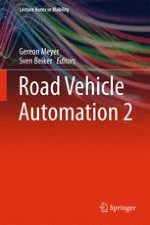2015 | OriginalPaper | Buchkapitel
Human Factors Considerations for the Design of Level 2 and Level 3 Automated Vehicles
verfasst von : Janet I. Creaser, Gregory M. Fitch
Erschienen in: Road Vehicle Automation 2
Aktivieren Sie unsere intelligente Suche, um passende Fachinhalte oder Patente zu finden.
Wählen Sie Textabschnitte aus um mit Künstlicher Intelligenz passenden Patente zu finden. powered by
Markieren Sie Textabschnitte, um KI-gestützt weitere passende Inhalte zu finden. powered by
